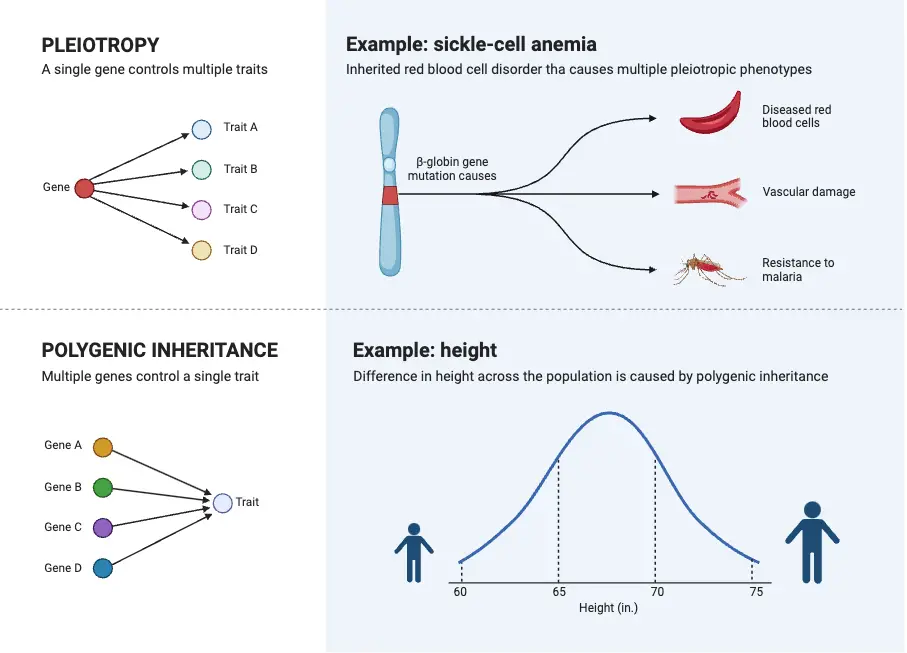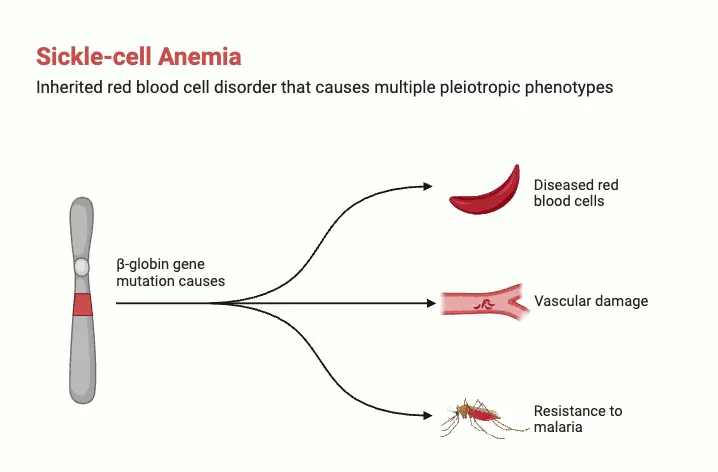What is Pleiotropism?
- Pleiotropism, also referred to as pleiotropy, is a genetic phenomenon where a single gene influences multiple, seemingly unrelated phenotypic traits. In essence, one gene can have wide-reaching effects, impacting various aspects of an organism’s biology. This multifaceted genetic influence is a key concept in genetics, especially when examining how certain genes contribute to the overall complexity of an organism’s development and function.
- A mutation in a pleiotropic gene can have a significant impact on one or several of the traits it influences. Depending on the role of the gene in different biological pathways, such mutations might cause mild to severe changes in the affected phenotypes. This wide range of influence makes pleiotropy a crucial concept in understanding the relationship between genotype and phenotype.
- The mechanism behind pleiotropy is largely tied to a gene’s influence on metabolic pathways. Since metabolic pathways are essential for various cellular functions, a gene involved in these pathways can affect multiple traits simultaneously. For instance, the production of a specific enzyme may be involved in different developmental processes, and a disruption in this enzyme could lead to widespread phenotypic changes.
- Genes that display pleiotropy behave like non-pleiotropic genes in terms of producing a single polypeptide. However, the polypeptide produced by pleiotropic genes governs biochemical reactions that are integral to many developmental events. Because of this, any impairment in the function of the pleiotropic gene can have far-reaching consequences across different physiological systems.
- The term “pleiotropy” was first introduced in 1910 by Festschrift, and it derives from Greek origins. The word “pleio” means “more,” and “tropy” means “character,” which reflects the idea that one gene can affect multiple characteristics. Understanding pleiotropy provides insight into how interconnected biological processes are and how genetic variations can influence an organism in more ways than initially expected.

Short Definition of Pleiotropism
Pleiotropism refers to the phenomenon where a single gene or mutation affects multiple, seemingly unrelated traits or physiological processes. This occurs when one genetic change leads to a range of different effects across various aspects of an organism’s phenotype.
Types of pleiotropy
- Artefactual Pleiotropy
- Definition: Artefactual pleiotropy occurs when mutations affect multiple traits due to the physical proximity of genes on the genome. This is often an artifact of the mutagenesis process rather than a reflection of a direct biological relationship.
- Example: In Drosophila, the claret-nondisjunction alleles are known to influence both eye color (claret phenotype) and meiosis (increased nondisjunction). Investigation revealed that these effects are due to deletions affecting two adjacent genes—one coding for a kinesin involved in chromosome disjunction and another linked to eye color. Similarly, in C. elegans, mutations in the unc-86 gene, which codes for a POU-domain transcription factor, can affect both terminal cell divisions and meiotic nondisjunction due to deletions impacting adjacent transcription units.
- Significance: Artefactual pleiotropy often arises from small deletions rather than point mutations and can be exacerbated in organisms with compact, gene-dense genomes, such as Drosophila and C. elegans. These phenomena highlight the impact of gene proximity and chromatin organization on mutation effects.
- Secondary Pleiotropy
- Definition: Secondary pleiotropy, also known as relational pleiotropy, describes scenarios where a single biochemical abnormality leads to multiple phenotypic consequences. The initial mutation may result in a primary biochemical defect, which then cascades into various secondary effects.
- Example: Phenylketonuria (PKU) provides a classic case of secondary pleiotropy. The mutation in the enzyme phenylalanine hydroxylase leads to elevated phenylalanine levels, which disrupt myelination in the brain and result in mental retardation. Another example includes rudimentary mutations in Drosophila, affecting pyrimidine biosynthesis and leading to defective wing development due to cell division limitations in the wing disc.
- Significance: This type of pleiotropy underscores how a single biochemical defect can lead to a complex array of phenotypic outcomes, often through indirect pathways and physiological compensations.
- Adoptive Pleiotropy
- Definition: Adoptive pleiotropy, or exaptational pleiotropy, occurs when a protein with an original function is co-opted for an additional, unrelated role in different tissues.
- Example: Crystallin proteins in the lens of the eye, such as ε-crystallin and τ-crystallin, originally metabolic enzymes, have been repurposed to play structural and refractive roles. This illustrates how proteins can acquire new functions beyond their original biochemical roles.
- Significance: Adoptive pleiotropy highlights evolutionary processes where pre-existing proteins are adapted for new functions, illustrating the flexibility and resourcefulness of protein use in biological systems.
- Parsimonious Pleiotropy
- Definition: Parsimonious pleiotropy involves a single enzyme or protein performing identical biochemical functions across multiple pathways, thereby affecting various physiological processes.
- Example: In bacteria, certain enzymes involved in the biosynthesis of isoleucine and valine act on different substrates but are used interchangeably in these pathways. Similarly, the β subunit of G proteins in C. elegans is utilized in multiple signaling pathways without independent regulation.
- Significance: This type of pleiotropy reflects the efficiency of biological systems in utilizing a single protein or enzyme for multiple functions, simplifying metabolic regulation.
- Opportunistic Pleiotropy
- Definition: Opportunistic pleiotropy refers to instances where a protein or regulatory element assumes an additional role distinct from its primary function, often in different tissues.
- Example: In Drosophila, the genes sisB and runt, initially involved in sex determination, later take on roles as transcription factors in other developmental contexts. These opportunistic roles highlight how proteins can adapt to new functions over time.
- Significance: Opportunistic pleiotropy demonstrates how proteins can acquire secondary functions in response to evolutionary pressures, contributing to the versatility and adaptability of biological systems.
- Combinatorial Pleiotropy
- Definition: Combinatorial pleiotropy occurs when a single protein interacts with different partners in various cell types, leading to diverse functional outcomes.
- Example: The POU-domain transcription factor encoded by the unc-86 gene in C. elegans affects multiple neuronal functions, such as touch sensitivity and locomotion, by interacting with different protein partners in various neuronal contexts.
- Significance: This type of pleiotropy underscores the role of protein-protein interactions in generating diverse biological effects, emphasizing the complexity of regulatory networks in multicellular organisms.
- Unifying Pleiotropy
- Definition: Unifying pleiotropy involves a single gene or locus that integrates multiple chemical activities or functions into a cohesive biological role. The diverse functions may be interconnected at a broad biological level but differ at a molecular or chemical level.
- Example: The cha-1 and unc-17 genes in C. elegans encode choline acetyltransferase and the acetylcholine transporter, respectively. These genes overlap and share regulatory elements, demonstrating how multiple enzymatic activities can be unified under common biological processes.
- Significance: Unifying pleiotropy reflects the organization of genes and proteins to perform complex, multi-faceted biological functions, often providing evolutionary advantages through integrated functional units.
Examples of Pleiotropism
- Phenylketonuria (PKU)
- Cause: PKU is a genetic disorder caused by a mutation in a single gene that codes for the enzyme phenylalanine hydroxylase. This enzyme is responsible for converting the amino acid phenylalanine into tyrosine.
- Mechanism: In individuals with PKU, the mutation reduces or completely halts the conversion of phenylalanine to tyrosine, leading to an accumulation of phenylalanine in the bloodstream.
- Effects: High levels of phenylalanine are toxic to the developing nervous system of infants and can lead to mental retardation. Moreover, because tyrosine is a precursor for melanin, the failure to produce enough tyrosine results in reduced pigmentation of hair and skin. Therefore, PKU showcases pleiotropy by affecting both neurological development and physical appearance, such as skin and hair pigmentation.
- Sickle Cell Disease
- Cause: Sickle cell disease arises from a mutation in the beta-globin gene, which leads to the production of abnormal hemoglobin.
- Mechanism: The mutation causes red blood cells to take on a sickle shape instead of their normal biconcave, disc-like form. This abnormal shape leads to clumping of red blood cells, which can block blood flow in vessels.
- Effects: The single gene mutation not only disrupts the function of red blood cells but also causes various health issues. Blockages in blood vessels lead to organ damage in the heart, brain, and lungs, illustrating the pleiotropic nature of the mutation. Sickle cell disease thus impacts multiple organ systems, all stemming from a single genetic change.

Significance of Pleiotropism
- Understanding Genetic Complexity: Pleiotropism reveals how a single gene can influence multiple traits, highlighting the complexity of genetic interactions and the interconnectedness of biological pathways.
- Disease Mechanisms: It helps in understanding how mutations in a single gene can lead to diverse clinical manifestations, which is crucial for diagnosing and developing treatments for genetic disorders with multiple symptoms.
- Evolutionary Insights: Pleiotropism provides insights into evolutionary processes, showing how genes can acquire new functions or affect multiple traits, which can drive evolutionary change and adaptation.
- Drug Development: Recognizing pleiotropic effects is important in pharmacology, as drugs targeting a single gene might have unintended effects on other traits, impacting drug efficacy and safety.
- Predicting Phenotypic Outcomes: Understanding pleiotropy aids in predicting the broader impact of genetic variations on an organism’s overall phenotype, which is valuable for fields like genetics and developmental biology.
Reference
- https://www.slideshare.net/slideshow/pleiotropism/53723338
- http://www.jnkvv.org/PDF/25042020093849244201650.pdf
- https://www.pw.live/chapter-genetic-basis-of-inheritance-class-12/pleiotropy
- http://courseware.cutm.ac.in/wp-content/uploads/2020/05/L-6.pdf
- https://gyansanchay.csjmu.ac.in/wp-content/uploads/2022/08/penetrance-expressivity.-pleiotropy.pdf
- http://www.jnkvv.org/PDF/30042020115418304201027.pdf
- https://citeseerx.ist.psu.edu/document?repid=rep1&type=pdf&doi=abd5660417e132e73ec8268d9b3f87e0469ac5d9
- https://en.wikipedia.org/wiki/Pleiotropy
- Text Highlighting: Select any text in the post content to highlight it
- Text Annotation: Select text and add comments with annotations
- Comment Management: Edit or delete your own comments
- Highlight Management: Remove your own highlights
How to use: Simply select any text in the post content above, and you'll see annotation options. Login here or create an account to get started.